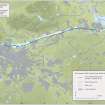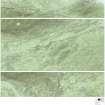Pricing Change
New pricing for orders of material from this site will come into place shortly. Charges for supply of digital images, digitisation on demand, prints and licensing will be altered.
Antonine Wall, Military Way
Frontier Defence (Roman), Roman Road (Roman)
Site Name Antonine Wall, Military Way
Classification Frontier Defence (Roman), Roman Road (Roman)
Canmore ID 228361
Site Number NS98SE 82.03
NGR NS 9680 8000
NGR Description NS 9680 8000 to NS 9999 8107
Datum OSGB36 - NGR
Permalink http://canmore.org.uk/site/228361
- Council Falkirk
- Parish Bo'ness And Carriden
- Former Region Central
- Former District Falkirk
- Former County West Lothian
NS98SE 82.03 9754 8016 to 9826 8043
NS 9754 8016 to NS 9800 8028 Postulated line of Military Way based on findings at NS 9754 8016 and stone accumulations at watercourses (Macdonald 1925).
Postulated course of Military Way, through mature afforestation is viable, but there is insufficient evidence for publication. Concentrations of stone in drain cuttings were noted.
NS 9754 8016 Kerbing of Military Way based on trenching. (Location measurements given) (Macdonald 1925)
NS 9800 8028 to NS 9826 8043 Postulated line of Military Way based on excavation (1915 and 1932) and observation (Macdonald 1925, 1934)
There is no surface evidence of the Military Way in this alignment.
Information from OS 1980
G Macdonald 1925; G Macdonald 1934.
Trial Trench (1915)
NS 9754 8016 Kerbing of Military Way based on trenching. (Location measurements given) (Macdonald 1925)
Excavation (1915)
NS 9800 8028 to NS 9826 8043 Postulated line of Military Way based on excavation (1915 and 1932) and observation (Macdonald 1925, 1934)
Field Visit (1925)
NS 9754 8016 to NS 9800 8028 Postulated line of Military Way based on findings at NS 9754 8016 and stone accumulations at watercourses (Macdonald 1925).
Excavation (1934)
NS 9800 8028 to NS 9826 8043 Postulated line of Military Way based on excavation (1915 and 1932) and observation (Macdonald 1925, 1934)
Field Visit (1980)
NS 9754 8016 to NS 9800 8028 Postulated course of Military Way, through mature afforestation is viable, but there is insufficient evidence for publication. Concentrations of stone in drain cuttings were noted.
Information from OS 1980
Field Visit (1980)
NS 9800 8028 to NS 9826 8043 There is no surface evidence of the Military Way in this alignment.
Information from OS 1980
Magnetometry (27 May 2008 - 13 June 2008)
NS 97750 80380 (fortlet) – NS 98100 80500 (medieval church environs).
Fortlet area: The Antonine Ditch and Rampart have been detected by both techniques, but the anomalies become less coherent in the western half of the site; this ties in with excavation results which reported increased levels of damage to features (particularly the rampart) around the western half of the fortlet. The outline of the fortlet rampart can be partly traced in the resistance data and the surrounding ditch has produced relatively coherent magnetic anomalies. Although some anomalies of possible
interest are present within and immediately adjacent to the fortlet, poor definition makes an archaeological interpretation tentative.
Medieval church / village environs: The many phases of land use at this site (Roman, Medieval, Post Medieval, modern) have given rise to somewhat confusing geophysical results. The Antonine Ditch has been detected, but the anomalies are neither characteristic nor definitive. No anomalies consistent with the Rampart have been identified and their absence has made it impossible to clarify the exact line of the Wall at the eastern end of the site, where a possible deviation from the published line has been
suggested. An enclosure round the churchyard has been located, appearing most clearly in the magnetic results. Outside of this, several anomalies, primarily in the resistance data, may be associated
with medieval settlement, but could equally have been produced by more recent landscaping of the site.
C. Stephens
Earth Resistance Survey (27 May 2008 - 13 June 2008)
NS 97750 80380 (fortlet) – NS 98100 80500 (medieval church environs).
Fortlet area: The Antonine Ditch and Rampart have been detected by both techniques, but the anomalies become less coherent in the western half of the site; this ties in with excavation results which reported increased levels of damage to features (particularly the rampart) around the western half of the fortlet. The outline of the fortlet rampart can be partly traced in the resistance data and the surrounding ditch has produced relatively coherent magnetic anomalies. Although some anomalies of possible
interest are present within and immediately adjacent to the fortlet, poor definition makes an archaeological interpretation tentative.
Medieval church / village environs: The many phases of land use at this site (Roman, Medieval, Post Medieval, modern) have given rise to somewhat confusing geophysical results. The Antonine Ditch has been detected, but the anomalies are neither characteristic nor definitive. No anomalies consistent with the Rampart have been identified and their absence has made it impossible to clarify the exact line of the Wall at the eastern end of the site, where a possible deviation from the published line has been
suggested. An enclosure round the churchyard has been located, appearing most clearly in the magnetic results. Outside of this, several anomalies, primarily in the resistance data, may be associated
with medieval settlement, but could equally have been produced by more recent landscaping of the site.
C. Stephens
Archaeological Evaluation (1 October 2016 - 30 November 2016)
NS 97480 80320 - This evaluation was carried out in support of the design of access improvement work for a footpath along a stretch of the Antonine Wall in Kinneil Woods. All works were conducted under the terms of Scheduled Monument Consent, issued and overseen by Historic Environment Scotland.
Three trenches were excavated within the study area to characterise the visible bank running on the top lip of the Cow Bank, and the character of the existing path immediately downslope. The bank proved to be a relatively slight simple earthen feature, while the modern path lay within a much broader ledge that appears to have been cut when it was built. The only artefact recovered was a ceramic base sherd from a white glazed pottery vessel of post medieval or later date from within bank material.
While the works provide information to assist the design work, no conclusive information was garnered as to the origin of the visible bank. By inference, it is slightly more likely this is a post-medieval feature – but this cannot be confirmed.
Information from OASIS ID: rathmell1-270018 (L McKinstry) 2016










